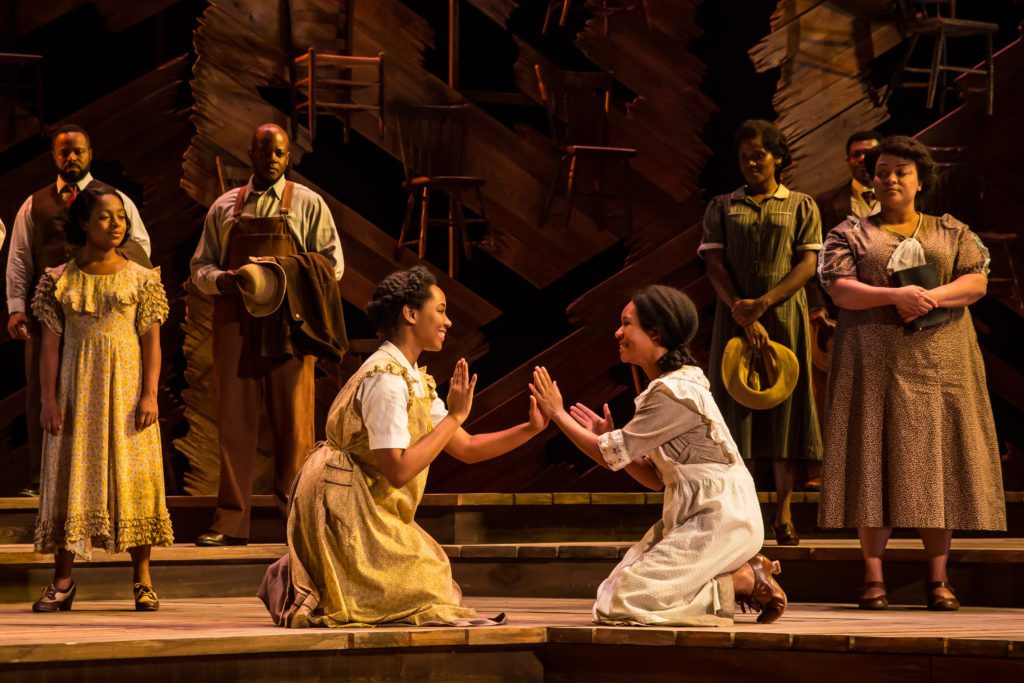The Life and Lives of Alice Walker’s Celie
By • August 8, 2018 0 914

One is amazed by the life and lives Celie has led and embodied.
She was born in triumph, often accompanied by controversy, the aura of which sometimes still remains. Writer Alice Walker, herself the focus of controversy over the years, gave Celie birth as the central character in her 1982 Pulitzer Prize-winning novel “The Color Purple.”
Celie began literary life on the page as a 14-year-old African American girl living a dark, often brutally victimized life in the 1930s American South, married off to the abusive man named “Mr.” who beat and raped her regularly. But Celie is a survivor, through her children, her family and her friendships with strong women.
Given the often graphic, unvarnished, violent nature of the life she endures during the course of the novel, it’s remarkable how Celie has endured in the imaginations of readers and of subsequent audiences for later incarnations of “The Color Purple.”
The novel re-emerged in 1985 as a critically acclaimed and popular film directed by Stephen Spielberg. It featured the comic actress and now icon Whoopi Goldberg as Celie and Oprah Winfrey — simply Oprah now — as the spirited and suffering Sofia (neither had had film experience), as well as Danny Glover as “Mr.” and Margaret Avery as the charismatic Shug Avery.
Critic Roger Ebert named it the best movie of the year, although not everyone agreed. The movie was nominated for 11 Oscars, failing to win any, and netted over $142 million in worldwide box office returns.
It was a triumph for Spielberg — in spite of his more sentimental approach to Walker’sgritty material — and the net result was to give “The Color Purple” a permanent kind of literary appeal, even as school librarians, especially in the South, made continual efforts to ban the novel. The book was a difference maker.
“The Color Purple” next appeared on the radar as a Broadway musical that first appeared in 2005 and ran through 2008, with music and lyrics by Stephen Bray, Brenda Russell and Allee Willis and a book by noted playwright Marsha Norman (“’Nite Mother”). La Chanze starred as Celie and won a Tony Award. There were three national tours and, eventually, a Broadway revival that opened in 2015 and won a best-revival Tony.
And now the national tour, directed by John Doyle of “Sweeney Todd” and “Company” fame,is booked into the Kennedy Center Eisenhower Theater through Aug. 26.
Celie has come a long way, more in triumph than as a matter of endurance.
Twenty-nine-year old Adrianna Hicks wasn’t even alive when “The Color Purple” first appeared as a novel or when the Spielberg movie emerged. But the McKinney, Texas, native is starring as Celie in the current tour.
“It’s much more focused on the music, the story and the characters, less so on spectacle,” Hicks said.
Hicks came to become Celie in a somewhat roundabout way, but in a journey that in the end had its inevitable and highly focused aspects.
“To me, it’s about redemption and forgiveness, and that makes it important today, as wellas when it first came to the stage, or when it was written,” she said.
Hicks saw her first musical in high school — it was “Guys and Dolls,” a far cry from the wrenching dramatics of “The Color Purple.” She also saw “The Color Purple” when she was
in high school, where she had already set her sights on musical theater. As a theater student, she went on a school trip to New York, where “Purple” was the last musical she saw. She also met Whoopi Goldberg in a visit to New York. After winning a scholarship from the Congressional Black Caucus, she earned a B.F.A at the University of Oklahoma.
“I had to make a choice, whether to try to go to New York, but I was offered a chance to perform in touring companies of musicals in Europe, in Germany and Austria,” where sheperformed in “Sister Act” and “Legally Blonde.”
When she returned, she landed a “swing” role on the revival of “The Color Purple.” “I didabout seven of the nine roles in the show, including Celie,” she said. “When the opportunity came for the national tour, I was eventually offered the role … Every day, I feel blessed just to be able to do this.”
She commented: “It’s funny, with this tour. I’ve lived in Europe, but I’ve never really seenmy own country, and now I am … It’s different everywhere you go. Some audiences you cantell they’re really in the play, others are quieter. It’s just an awesome experience, every time out. You can really tell at the curtain call.”
On the phone, Hicks comes across as very much her own Celie. Her voice in conversation is rangy, high-spirited, in the moment, willing to laugh or show emotion.
“I think everyone that has done this part is her own Celie,” she says. “You truly bring yourself to it.”
In that way, Hicks moves Celie’s life, her plight and courage into the present, where she’svery much pertinent, alive, where the color purple glows in the klieg lights.

